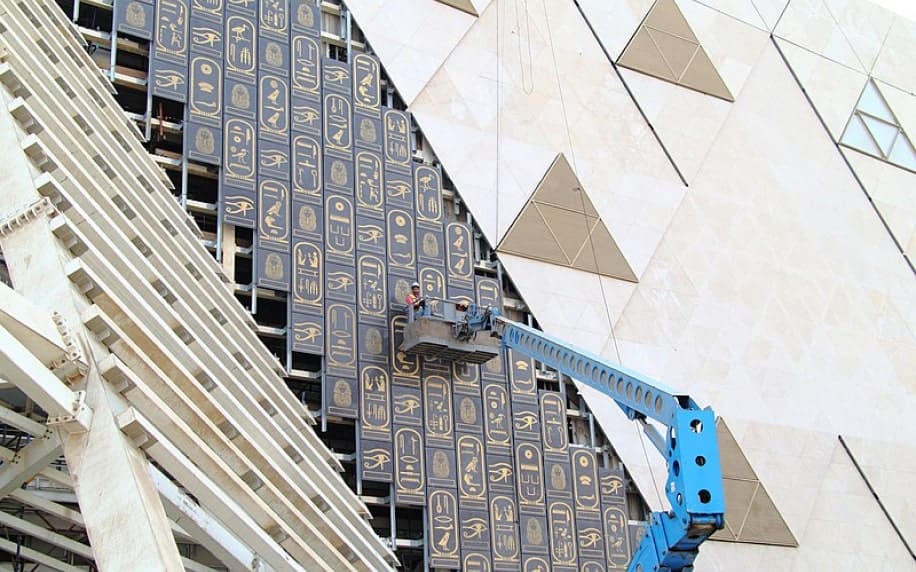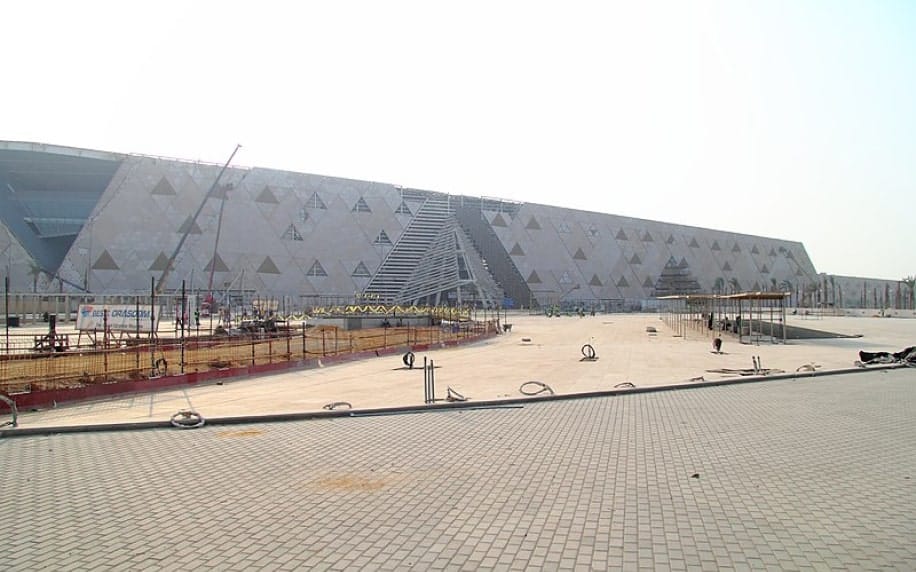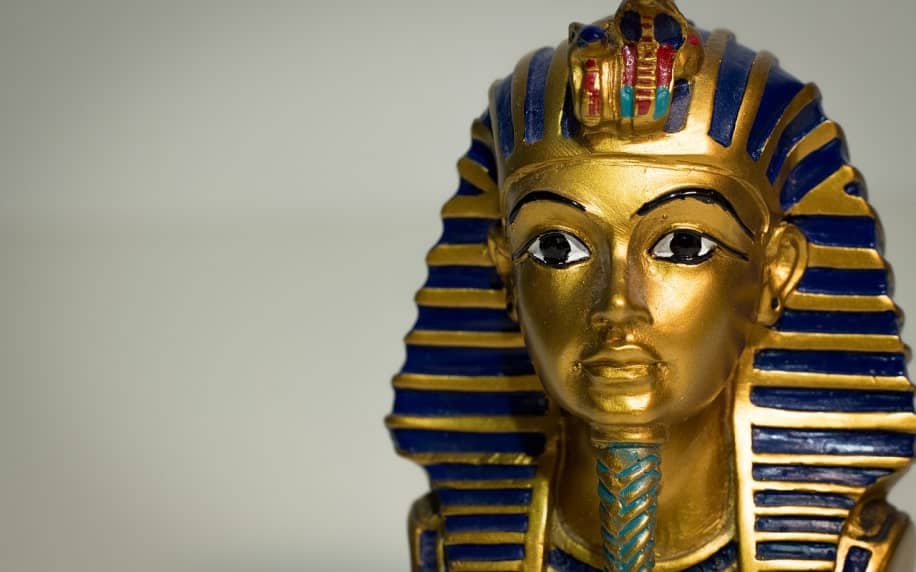The Upcoming Inauguration of the Grand Egyptian Museum (GEM)

Updated On: April 15, 2024 by Ciaran Connolly
“The Grand Egyptian Museum is the most important cultural project in the world in the twenty-first century. It will be the greatest and largest museum in the world, and the interior design and display of antiquities will be dazzling.”
With the words of the famous Egyptian archaeologist and former Minister of Antiquities, Dr Zahi Hawass, we’d like to invite you to explore with us one of the most exciting upcoming projects in Egyptian tourism. Dr Hawass also added that the new museum will be “a message to the whole world that Egypt preserves its antiquities and preserves its heritage more than any other country, and it will be a gift from Egypt to the world, including the antiquities it contains, foremost among which is the statue of Ramses II and the monuments of Tutankhamun.”
The Grand Egyptian Museum is considered to be the biggest museum in Egypt, and will also be the largest museum containing monuments from a single civilization. It is located about two kilometres away from the pyramids of Giza, constructed over 120 acres.
When the museum is opened to the public, it will contain some of Egypt’s most precious relics, and it is expected to attract around five million visitors a year.
The museum was supposed to be opened in the first quarter of 2020, but due to the spread of the COVID-19 pandemic, the museum opening was moved to 2022. A lot of preparations are underway for the grand opening ceremony that will host many important figures from across the world, excited to witness the new centre for culture and civilization. The opening ceremony will reportedly include a procession where the antiquities and relics are transferred from the Egyptian Museum in Tahrir Square to the Grand Egyptian Museum in Giza. Since the mummies of several ancient Egyptian kings and queens will also be transferred to the new museum, the procession will be similar to the funeral processions of ancient Egypt, with all their grandeur, fit for the status of the mummies of the ancient rulers.
Huge developments and renovations are being conducted on all the roads leading to the Grand Egyptian Museum, starting from the nearby Sphinx Airport and Cairo International Airport to the museum.
Its strategic position will allow tourists and visitors to conveniently visit the museum after touring the Pyramids of Giza and the Sphinx, after arriving at the nearby Sphinx Airport. The area also contains many five and four-star hotels welcoming travellers from around the globe every day.
We thought we’d answer some of the most common questions about the Grand Egyptian Museum below:
When will the Grand Egyptian Museum open?
So far, the inauguration is expected to be sometime in late 2022.
How can we get to the Grand Egyptian Museum Complex Contain?
The museum can be reached easily from the Pyramids area. A Tourist Walk will be constructed so as to lead the tourists from the Pyramids of Giza to the museum and its about 2 kilometres long. The walkway will allow tourists to go from one place to another either with cars or on foot.
The Grand Egyptian Museum is also close to the Cairo ring road, the freeway circling Cairo’s metropolitan area. It will be connected to the Cairo metro when the new line is completed and, conveniently, can be reached by air: the new Sphinx International Airport, 20 minutes away, will receive international flights, but the main advantage will be the domestic routes, making it an easy day trip from the Red Sea resorts.
Are there any other conveniences nearby?
A makeshift food court is currently being built within the area, which will contain 20 shops and 8 restaurants, in addition to a hotel with a capacity of 30 rooms.
How was the Grand Egyptian Museum built?
The Grand Egyptian Museum cost about 500 million dollars, 100 million through self-financing from the Egyptian Ministry of Antiquities, and the rest is $300 million from a soft loan from the Japanese (JICA) organization, in addition to $150 million in local and international donations and contributions.
The project was initially conceived in 2008, so JICA started to provide financial support by making two official development assistance loans available, the first in 2008 and the second in 2016, bringing the total value of loans to 84.2 billion Japanese yen which is about 800 million dollars, to support financing the construction of the museum building that includes exhibitions, information and communication technology infrastructure, in addition to consulting services that include supervision of construction works and supplies.
JICA also supports the Egyptian Ministry of Antiquities and the Grand Egyptian Museum to set up a system to manage and operate the museum in a sustainable way through developing the capabilities of the museum’s management staff, and the project includes capacity development in the areas of management, museum display, information and communication technology, in addition to educational programs for visitors and the transfer of artefacts.

How will the antiquities be handled in terms of restoration?
After the financial loan, there was technical cooperation, where JICA helped establish the Restoration Center of the Grand Egyptian Museum. The restoration centre plays a major role in preserving and restoring the monuments, which were collected and transported from various parts of Egypt to be displayed in the museum upon its opening. Also, that will help to develop the human recourse in working in the antiquities restoration sector in Egypt, hoping to expand to the countries of the Middle East and North Africa afterwards.
An Egyptian work team were put together to handle the archaeological database. This team contributed to developing the appropriate system and defining procedures for preparing the database through restructuring and developing the previous database to include more accurate and detailed information on artefacts, and JICA experts developed the human and institutional capabilities of the Egyptian cadres in the field of preserving antiquities at the Restoration Center, which contributes to achieving a more efficient and effective level of work. With the help of the National Research Institute for Cultural Heritage in Tokyo, JICA organized several training workshops on methods and techniques of restoration and conservation of antiquities in Egypt and Japan.
JICA’s Japanese experts conducted more comprehensive and specialized training programs for Egyptians working at the Restoration Center, with the aim of enhancing expertise and skills in the field of restoration and preservation of antiquities, and for the restoration centre at the Grand Egyptian Museum to become a pioneering centre according to global standards, experience and research on conservation of antiquities in the region, as JICA organized more than 100 training programs in the field of preservation and restoration of antiquities for about 2,250 participants over the course of the project.
What will be displayed in the Grand Egyptian Museum?
The level of cooperation between JICA and the Grand Egyptian Museum has been developed and strengthened through the launch of the joint Egyptian-Japanese restoration project, whereby Egyptian and Japanese experts work together to preserve, restore, package and transport 72 artefacts to be displayed in the Grand Egyptian Museum upon its opening, including antiquities, mummies, artefacts, textiles, wall paintings and stones, including the golden bed and war chariots of King Tutankhamun, as well as his personal belongings, such as the jacket, gloves, socks and clothes.

How did the concept of the Grand Egyptian Museum come about?
In order to start this enormous project, an architectural competition was announced on 7 January 2002. About 1557 entries from 82 countries were received by the organizers, which made it the second-largest architectural competition in history. The judging process was complete by 2 June 2003. The competition was won by architects Róisín Heneghan and Shi-Fu Peng, and their company Heneghan Peng Architects.
They had to find a location away from traffic in downtown Cairo which caused an issue when moving visitors to the old museum. So, the choice settled on a plot of land near the pyramids outside Cairo, on the edge of the Western Desert and that looks out on to the famous Pyramids of Giza, which is quite a strategic location and convenient for tourists everywhere.
In 2002, the late Egyptian President Hosni Mubarak laid the foundation stone of the Grand Egyptian Museum. After that, specifically in 2006, the statue of Ramesses II was moved from Ramses Square in Cairo to the Giza Plateau and in 2018, where it was placed at the large entrance of the new Grand Egyptian Museum with a great celebration held at that time.
The museum was supposed to be opened in 2012, but the Egyptian revolution came in 2011, which delayed the process altogether. Due to security concerns and dwindling funds, the government stopped construction from 2011 to 2014. The project came back to life after there was a loan from Japan and it was going to be opened partly in 2018 and then it was delayed to 2019 at that time.
The museum is highly secured and about 21 foreign companies contribute to the process of security systems and insurance and there are passages for security sterilization at the latest level to detect any foreign objects when the visitor passes them to enter the museum, in addition to tracking systems for the movement of the antiquities, and the fences are carefully monitored. A central control room monitors the paths and the roads and entry and exit gates are protected with heavy security.
What will happen to the old museum?
The old museum in Tahrir Square will be cleaned up and a renovation will be conducted as soon as everything is moved to the Grand Egyptian Museum. The old museum will not be closed, it will still house a world-class collection of antiquities, but it will only be visited by students and those who are interested in the wonders of this ancient land.
The statue of Djoser, the statue of Akhenaten and Hatshepsut and all their belongings, and several dozen pieces belonging to King Tutankhamun will be taken from it, as the Egyptian antiquities are enough to fill hundreds of museums with stunning displays.
How to begin your visit to the new museum?
All instructions will be posted in the museum in three languages: Arabic, English and Hieroglyphs.
The visitor’s path begins with the Obelisk Square, in which the first hanging obelisk in the world is displayed, and in front of it is the majestic facade of the museum. Then, you will find the wall of the pyramids which is 600 meters wide and 45 meters high, this is where the visitor enters the grand museum, where there are two main blocks. First, the museum building where Ramses II stands welcoming the visitors after being moved from Ramses square and beside him, you’ll find other statues moved from the old museum, such as the statue of King Senusret, the head of Basmatik I, and other statues.
This block contains many halls, but the hall that would be considered one of the important where many visitors would most likely be interested in the most is King Tutankhamun Hall, which includes more than 5,000 pieces that will be displayed for the first time in one place. Also, there will be a library of rare books, as well as a conference building which includes a 3D display hall, a cultural centre, the main restaurant square, a commercial walkway and shops, and as for the outdoor spaces, it includes the Sun Boat Museum, a group of restaurants, and many parks.
Before the final opening in 2022, there will be the last phase which will contain the construction of museum galleries, the Scholars Museum, the Convention and Film Center, the Archaeological Library, and the Children’s Museum.
How will all the antiquities be transferred?
It started with the transfer of the statue of Ramses II which was moved from its old location in Ramses Square in Cairo to be placed in its new location at the entrance to the Grand Egyptian Museum. The statue weighs 83 tons.
In 2016, there was another transfer of 778 artefacts from Luxor Governorate to the Grand Egyptian Museum, amid extensive security, as well as using distinctive protection and packaging methods, in accordance with international standards. This transfer included a large statue of King Amenhotep III and the god Horus of pink granite weighing about 4 tons, which will be displayed on the museum’s great staircase.
Another stage in transferring the antiquities of the Egyptian Museum to the Grand Egyptian Museum was transferring 525 artefacts. Among the transferred pieces are 367 pieces from King Tutankhamun’s holdings, in preparation for displaying them within his collection to be transferred completely to the Grand Museum upon the partial opening of the museum.
Additionally, the Khufu boat was transferred to the museum at various intervals in order to complete their restoration and display in the museum. Besides that, many pieces were transferred from all over Egypt to the new museum.
In December 2019, a group of rams in the first pylon of the Karnak Temple in Luxor were transferred to the Grand Egyptian Museum, at least 4 rams will be chosen for display. These rams represent the body of a lion and the head of a ram, which is the sacred symbol of the famous god Amun Ra.
How much will the entrance to the Grand Egyptian Museum cost?
For foreigners, the ticket price will be 400 Egyptian pounds and 200 Egyptian pounds for students to enter the Tutankhamun Hall, and for Egyptians, it will be 60 pounds and 30 pounds for the students and 500 pounds as a combined ticket price to visit all the halls.
We can’t wait for the historical opening in 2022. It will certainly become one of the most fascinating museums in the world, rivalling the Louvre and the British Museum due to its vast collections of ancient Egyptian antiquities, as well as artefacts from different time periods in Egyptian history.
The Grand Egyptian Museum is built to accommodate tourists and visitors for an entire day, where they can browse the available displays and relax at the restaurants and cafes within the same complex. There, you will find everything pertaining to the Pharaonic, Roman and Greek eras and get to know more about Egyptian history and some of the most famous figures that have never been forgotten thousands of years later.






